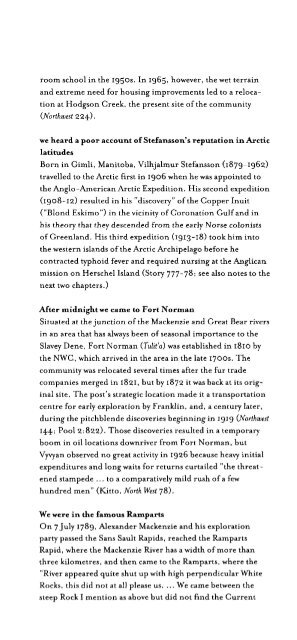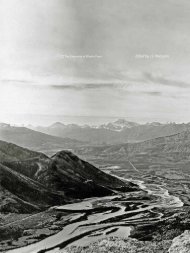C Ihe Ladies c cu. V'VVAN - History and Classics, Department of
C Ihe Ladies c cu. V'VVAN - History and Classics, Department of
C Ihe Ladies c cu. V'VVAN - History and Classics, Department of
- No tags were found...
Create successful ePaper yourself
Turn your PDF publications into a flip-book with our unique Google optimized e-Paper software.
Notes to Pages 49-52 257room school in the 1950s. In 1965, however, the wet terrain<strong>and</strong> extreme need for housing improvements led to a relocationat Hodgson Creek, the present site <strong>of</strong> the community(Northwest 224).we heard a poor account <strong>of</strong> Stefansson' s reputation in ArcticlatitudesBorn in Gimli, Manitoba, Vilhjalmur Stefansson (1879-1962)travelled to the Arctic first in 1906 when he was appointed tothe Anglo-American Arctic Expedition. His second expedition(1908-12) resulted in his "discovery" <strong>of</strong> the Copper Inuit("Blond Eskimo") in the vicinity <strong>of</strong> Coronation Gulf <strong>and</strong> inhis theory that they descended from the early Norse colonists<strong>of</strong> Greenl<strong>and</strong>. His third expedition (1913-18) took him intothe western isl<strong>and</strong>s <strong>of</strong> the Arctic Archipelago before hecontracted typhOid fever <strong>and</strong> required nursing at the Anglicanmission on Herschel Isl<strong>and</strong> (Story 777-78; see also notes to thenext two chapters.)Mter midnight we came to Fort NormanSituated at the junction <strong>of</strong> the Mackenzie <strong>and</strong> Great Bear riversin an area that has always been <strong>of</strong> seasonal importance to theSlavey Dene, Fort Norman (Tulit'o) was established in 1810 bythe NWC, which arrived in the area in the late 1700s. Thecommunity was relocated several times after the fur tradecompanies merged in 1821, but by 1872 it was back at its originalsite. The post's strategic location made it a transportationcentre for early exploration by Franklin, <strong>and</strong>, a century later,during the pitchblende discoveries beginning in 1919 (Northwest144; Pool 2:822). Those discoveries resulted in a temporaryboom in oil locations downriver from Fort Norman, butVyvyan observed no great activity in 1926 because heavy initialexpenditures <strong>and</strong> long waits for returns <strong>cu</strong>rtailed "the threatenedstampede ... to a comparatively mild rush <strong>of</strong> a fewhundred men" (Kitto, North West 78).stronger than elsewhere. We were still in Expectation <strong>of</strong>coming to the Rapid till they [Iocal people who talked toMackenzie's guide] told us there was no other but what we saw"(Mackenzie 190). W. Kaye Lamb, Mackenzie's modern editor,explains that the "sheer limestone cliffs 100 to 200 feet highconfine the river for seven miles within a channel that is only aquarter <strong>of</strong> a mile wide at the entrance, but widens gradually toabout half a mile" (Mackenzie 190).We came to Fort Good HopeSituated on the east bank <strong>of</strong> the Mackenzie River, Fort GoodHope (Rodili Ko) was established by the NWC in 1805. It is theoldest fur trading post in the lower Mackenzie Basin. TheRoman Catholic Mission was established there in 1859, <strong>and</strong> thesettlement was known for its church, Our Lady <strong>of</strong> Good Hope,which was decorated with murals by a Roman Catholic priest in1878 (Pool 2: 820).nsh-nets where we found corny, jack6.sh <strong>and</strong> bluenshNo doubt, the fish seen was a conny (short for poisson inconnu),not, as Vyvyan heard the name, "corny."Arctic Red RiverLocated at the junction <strong>of</strong> the Arctic Red <strong>and</strong> Mackenzie rivers,this site was probably a seasonal fishing camp for the Gwich'inbefore European contact. Roman Catholic members <strong>of</strong> theFort McPherson Gwich'in were drawn to Arctic Red River(Tsiigehtshik) when a Roman Catholic mission was established in1868. The HBC set up a post in the early 1870s, but thenumber <strong>of</strong> year-round permanent residents remained smalluntil well into the 1960s, as families lived on the l<strong>and</strong> trappingfor part <strong>of</strong> the year (Pool I:II2). Not until the late 1970s, withthe construction <strong>of</strong> the Dempster Highway <strong>and</strong> the ferrycrossing associated with it, did the community have wageemployment (Northwest lIO).We were in the famous RampartsOn 7 July 1789, Alex<strong>and</strong>er Mackenzie <strong>and</strong> his explorationparty passed the Sans Sault Rapids, reached the RampartsRapid, where the Mackenzie River has a width <strong>of</strong> more thanthree kilometres, <strong>and</strong> then came to the Ramparts, where the"River appeared quite shut up with high perpendi<strong>cu</strong>lar WhiteRocks, this did not at all please us .... We came between thesteep Rock I mention as above but did not find the Currentup the Peel River to Fort McPhersonLocated on the east bank <strong>of</strong> Peel River, Fort McPherson (Teet!'itZf,eh) sits at the eastern edge <strong>of</strong> Gwich' in territory. TheGwich'in already had access to Russian trade goods byway <strong>of</strong>Alaska when Alex<strong>and</strong>er Mackenzie passed through the region in1789; later, they traded with the HBC at Fort Good Hope,until 1840. In that year, John Bell <strong>of</strong> the HBC established PeelRiver Post on a site known in Gwich'in as Chii tsol dik (" Gravel on
















